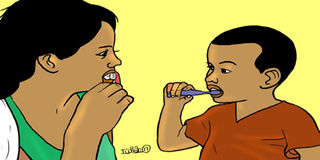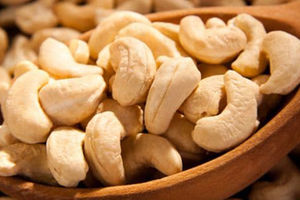PARENTING : Tooth care for young children

What you need to know:
- After her third birthday, you can use a pea-size amount. Be sure to follow these recommendations to avoid giving your child too much fluoride.
What’s the best way to brush my child’s teeth?
Use a small, soft toothbrush and a tiny amount of fluoride toothpaste. (It’s fine to use any fluoridated toothpaste. Note that many toothpastes marketed for babies and toddlers don’t contain fluoride.) As soon as your child’s teeth start erupting, use a thin smear of toothpaste or a dot the size of a grain of rice.
After her third birthday, you can use a pea-size amount. Be sure to follow these recommendations to avoid giving your child too much fluoride.
Twice a day, in the morning and at night after dinner, gently brush the teeth on both the inside and outside surfaces, as well as the tongue, to dislodge bacteria that can cause bad breath. Once you think your child can manage not to swallow the toothpaste, teach her to rinse with water. Replace the toothbrush as soon as the bristles start to look worn or splayed.
Your child’s dentist may also recommend flossing between any tooth surfaces that are touching. The best time to floss is right after brushing so the floss will draw fluoride from the toothpaste down between the teeth.
When can I let my child start brushing his own teeth?
As soon as he’s willing and able, it’s a good idea to let your child try to brush his own teeth, even though he probably won’t do a good job until he’s about 7 years old or so.
In the meantime, brush your teeth while he’s doing his, and then “check” each other’s teeth to see if they’re clean. Tell him you’ll get the spots he “missed” and let him get your “missed spots,” too.
What can I do if my child won’t brush?
If your child fusses when it’s time to brush, it might help to buy her a toothbrush with a special cartoon character on it.
Liz Johnso, a mother of three says this worked well for all her children. “My firstborn really hated brushing until I bought him an Elmo toothbrush. From that day on, he couldn’t get enough. It was just the ticket I needed to interest him in brushing.”
You can also let your child have several brushes in different colours so that she can choose the one she wants when it’s time to brush.
Does my child need fluoride?
Developing teeth can benefit from a little fluoride. This mineral prevents tooth decay by strengthening tooth enamel and making it more resistant to acids and harmful bacteria.
Your child can get fluoride from toothpaste, water, and, if needed, supplements. His dentist will also apply a fluoride varnish to his teeth at his dental checkups.
Most municipal water supplies are fortified with adequate fluoride. (Call your local water authority to find out about yours.) If your municipal water supply isn’t fortified or you get your water from a well, consider buying a test kit from your local health department, a hardware store, or a pharmacy.
If the fluoride content is less than .3 parts per million, ask your child’s doctor or dentist whether you should give your child a supplement. You can get a prescription for drops or chewable tablets.
Bottled water and fruit juices may also contain fluoride, although the amount isn’t always listed on the label.
Keep in mind that while a little fluoride is a good thing for your child’s teeth, swallowing too much of it over time can lead to a condition called fluorosis, which can cause white spots to show up on your child’s adult teeth.
That’s why it’s important not to use too much toothpaste, especially before your child learns to rinse and spit it out.
Are certain foods more likely to cause tooth decay?
Yes. Sweets (including fruit, dried fruit, juice, and foods such as peanut butter and jelly) and starches (such as breads, crackers, pasta, pretzels) can contribute to cavities.
Try to serve these foods at mealtime rather than as snacks so they’re more likely to get dislodged and won’t sit on the teeth too long. Serving them with water is also helpful.
When should I start taking my child to the dentist?
Experts recommend that you take your child to the dentist within six months after his first tooth erupts, or by his first birthday, whichever comes first.
If you haven’t taken your child for a dental checkup, make an appointment as soon as possible. Then follow the dentist’s guidelines for follow-up visits based on your child’s needs. If you can’t afford dental care for your child, consider getting in touch with your local health department to find out about resources.
Email: [email protected]




